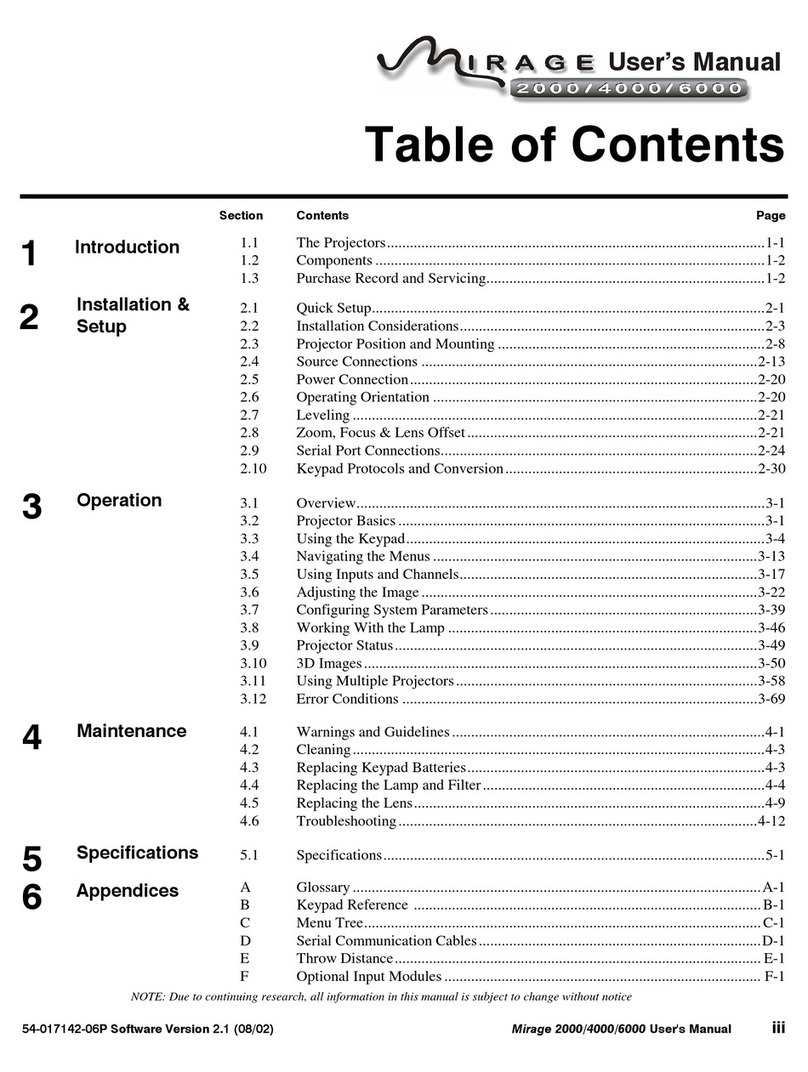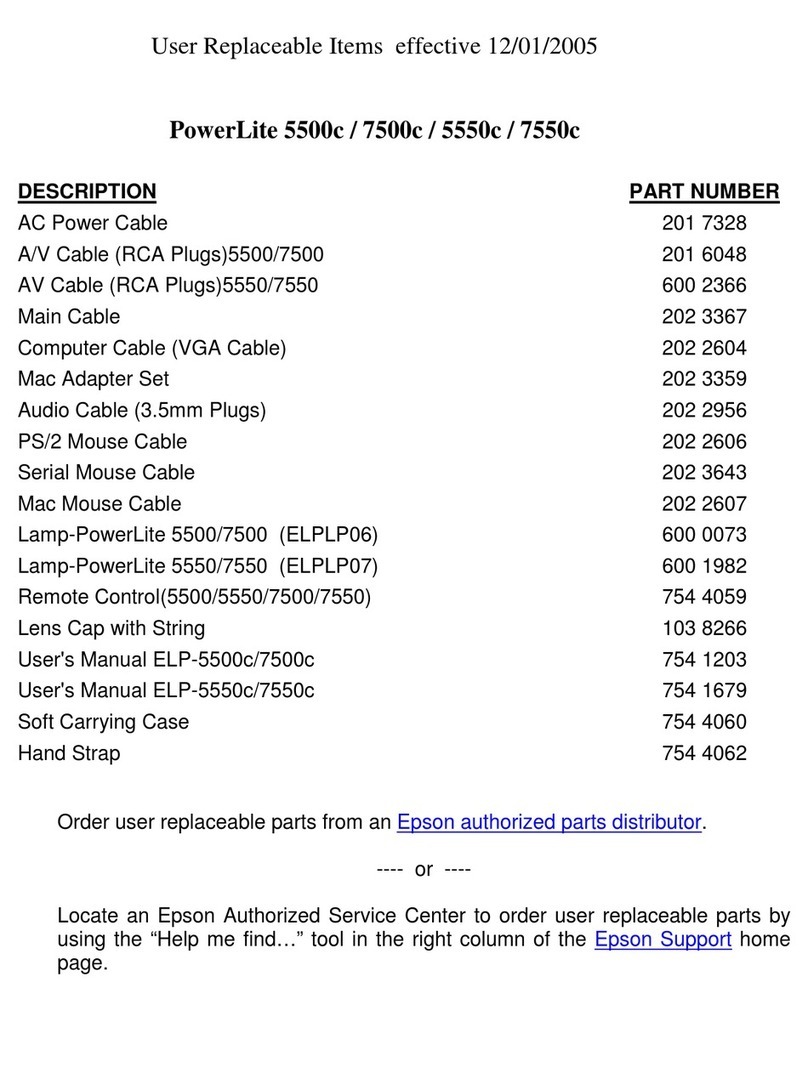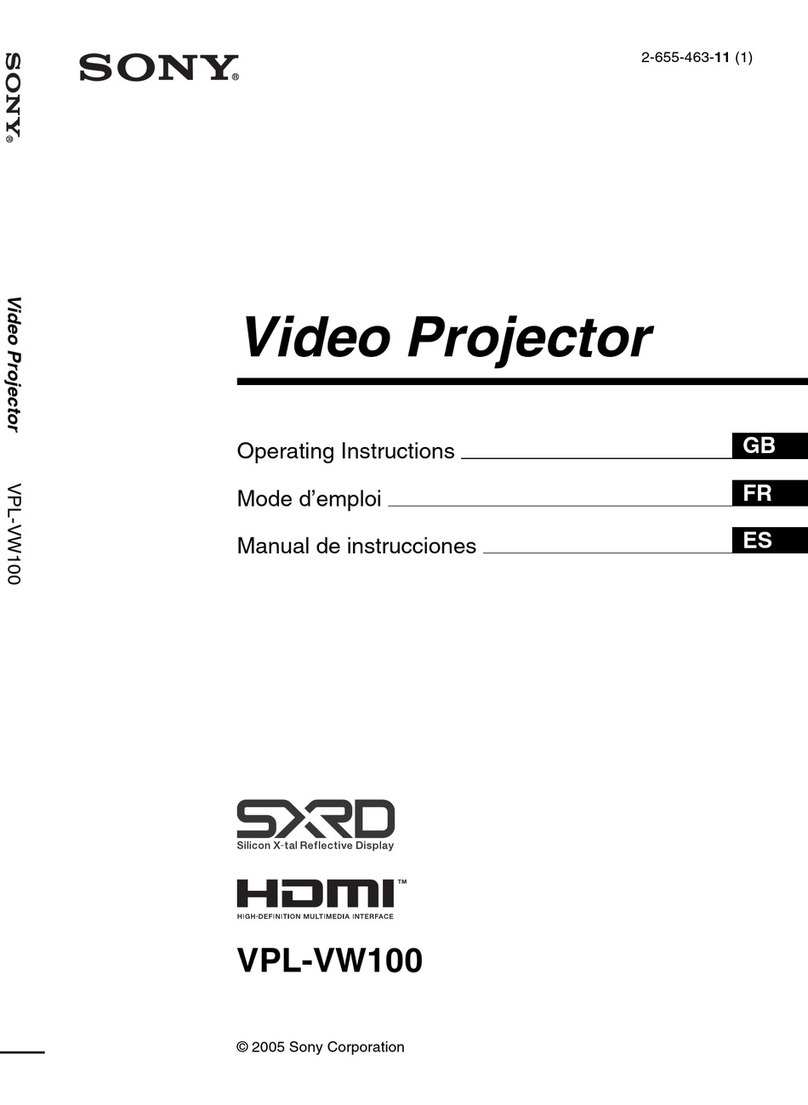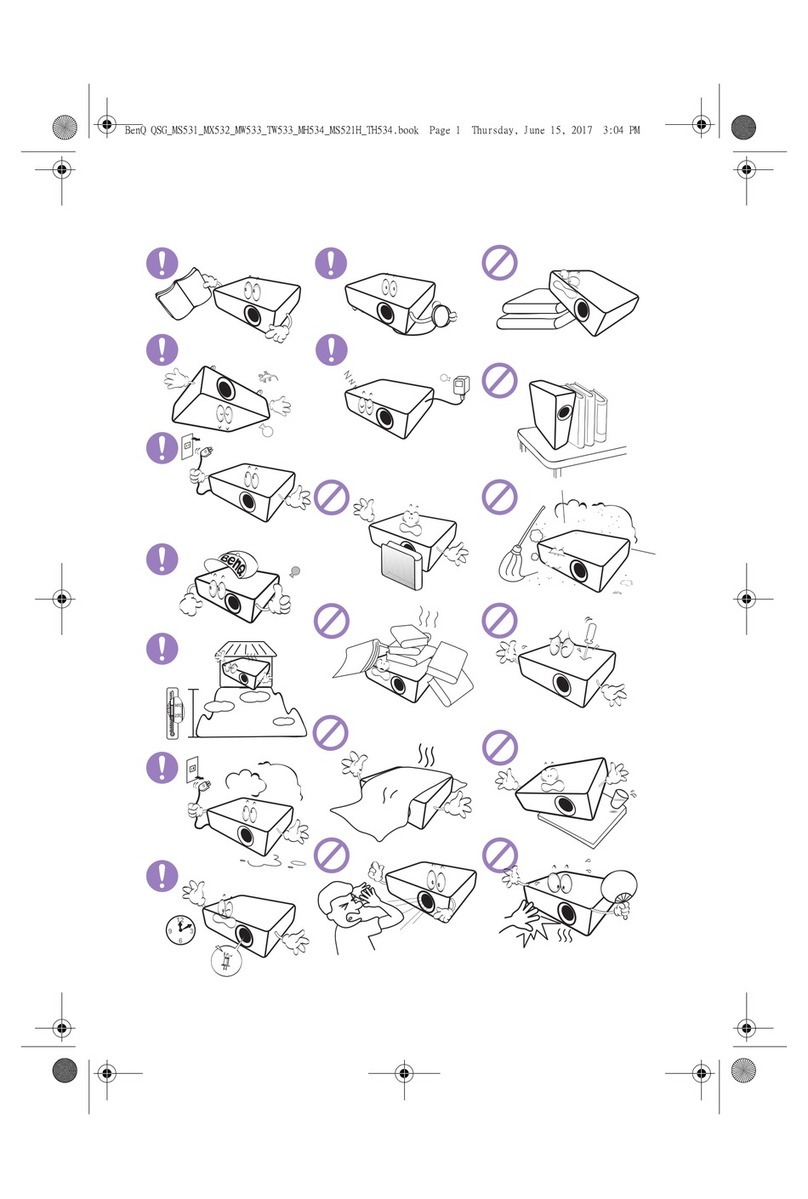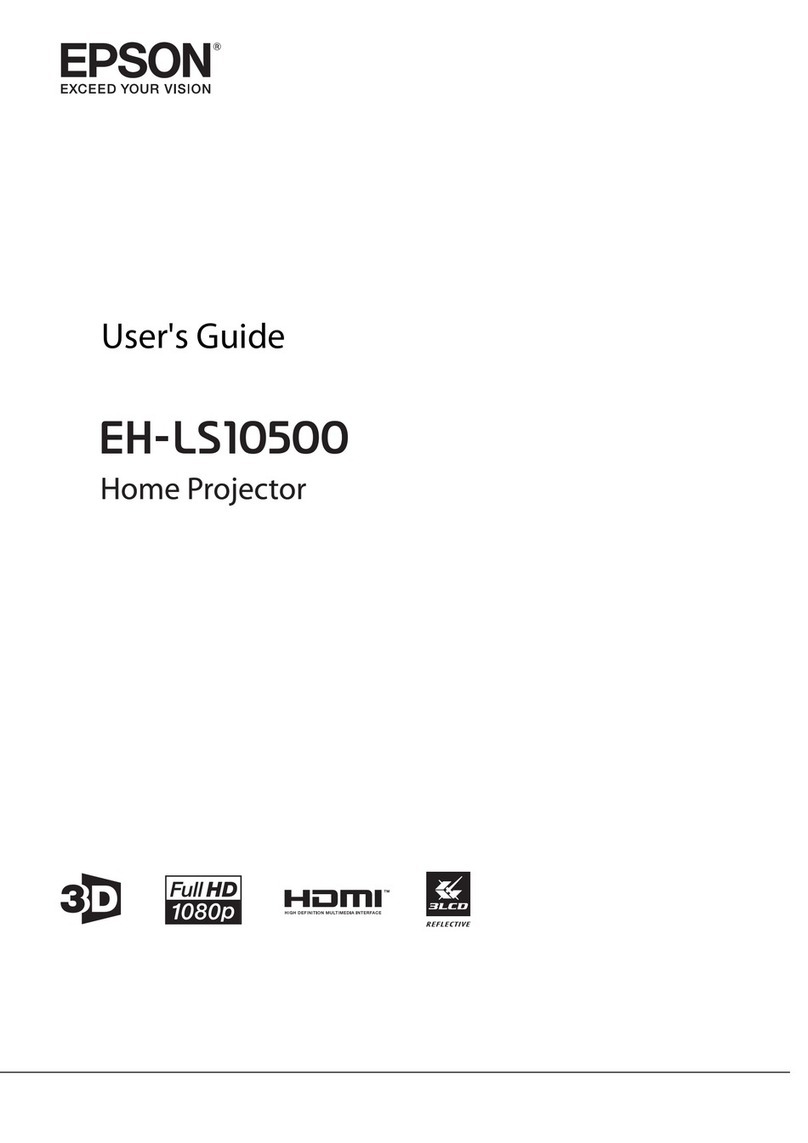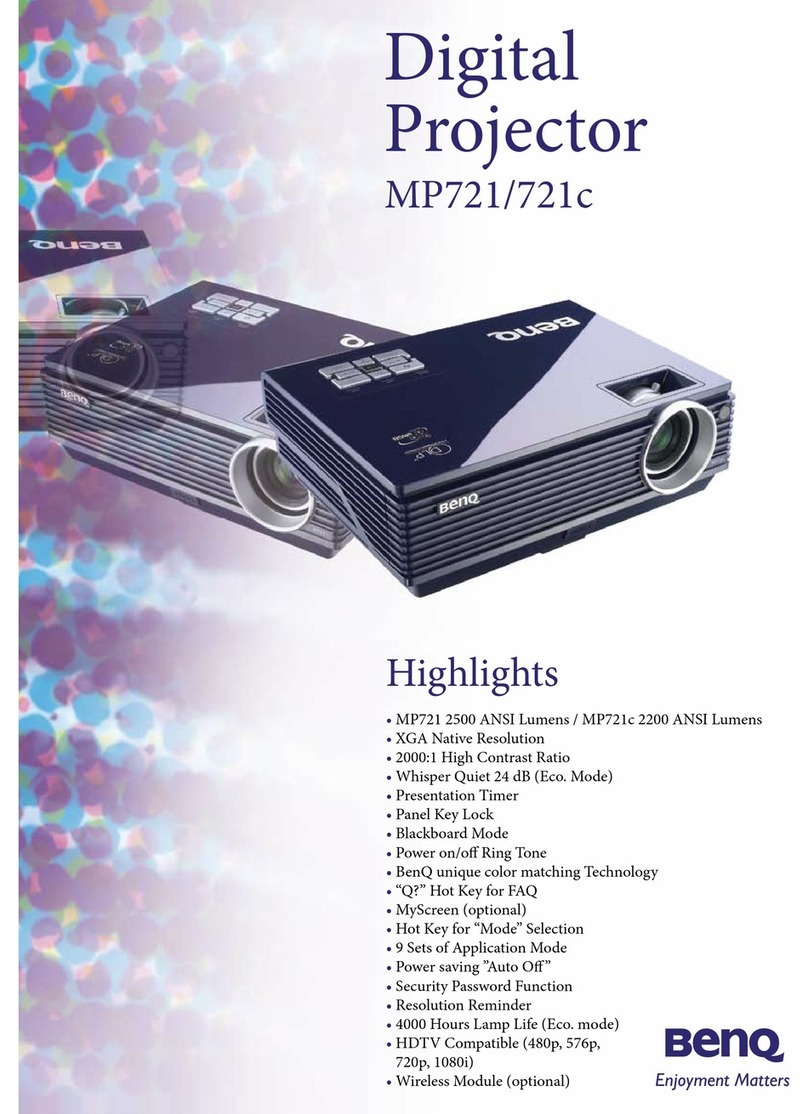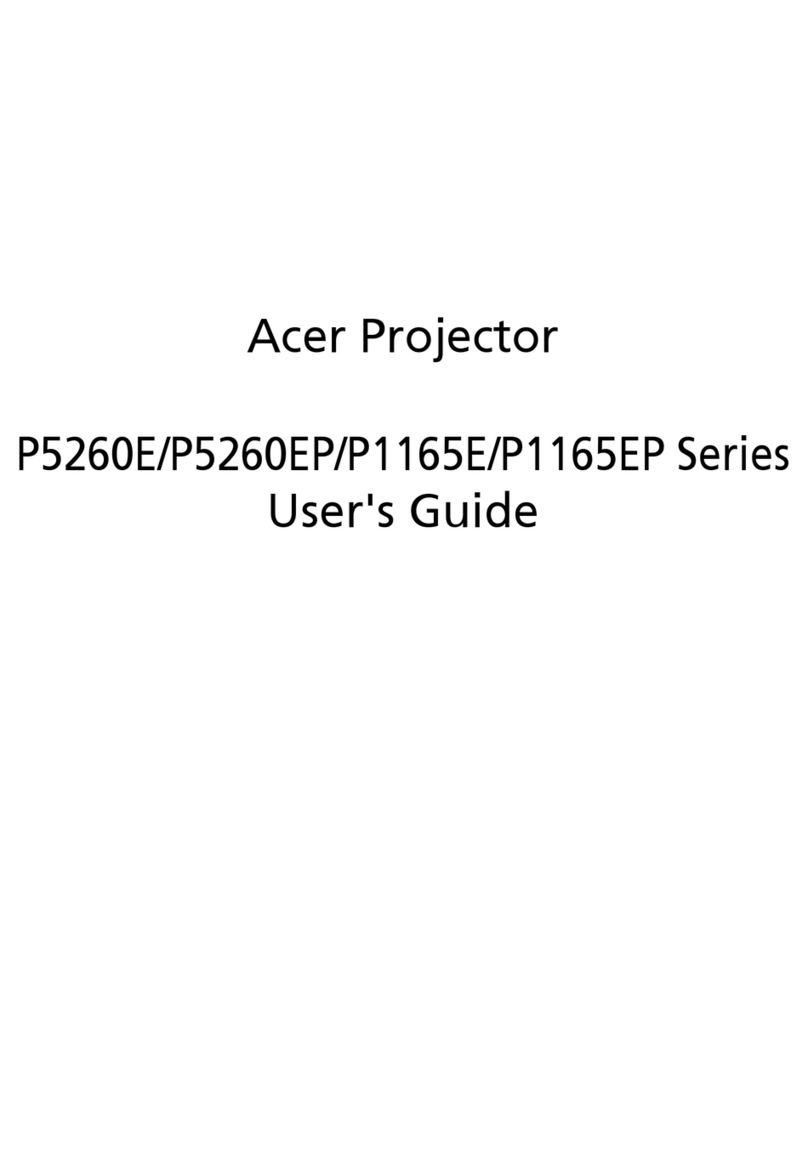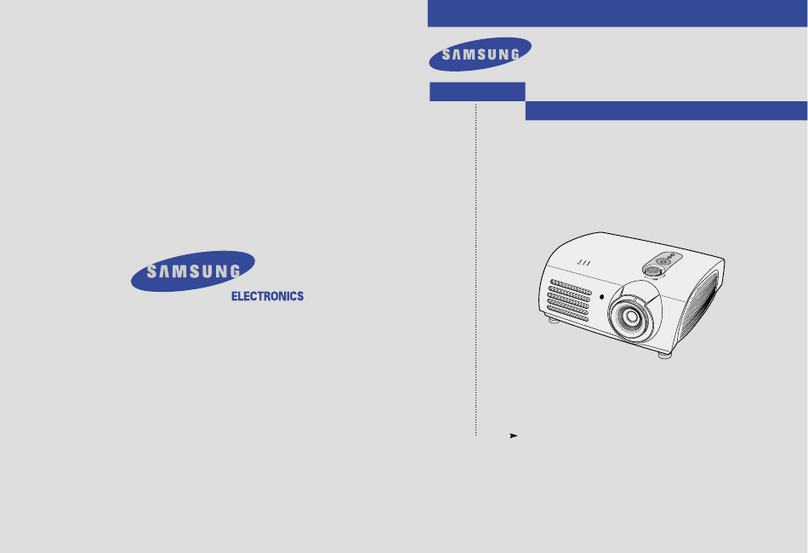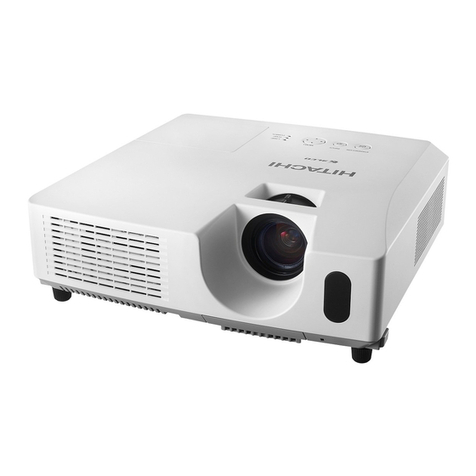Mirage 10000 User manual

8VHUV0DQXDO
7DEOHRI&RQWHQWV
3 6RIWZDUH 9HUVLRQ F
0LUDJH
8VHUV 0DQXDO
LLL
6HFWLRQ &RQWHQWV 3DJH
1.1 The Projector ....................................................................................................1-1
1.2 Components ......................................................................................................1-2
1.3 Purchase Record and Servicing.........................................................................1-2
2.1 Quick Setup.......................................................................................................2-1
2.2 Installation Considerations................................................................................2-3
2.3 Projector Position and Mounting......................................................................2-9
2.4 Source Connections ........................................................................................2-14
2.5 Power Connection...........................................................................................2-21
2.6 Operating Orientation .....................................................................................2-21
2.7 Leveling..........................................................................................................2-21
2.8 Zoom, Focus & Lens Offset............................................................................2-22
2.9 Serial Port Connections...................................................................................2-22
2.10 Keypad Protocols and Conversion..................................................................2-26
3.1 Overview...........................................................................................................3-1
3.2 Projector Basics................................................................................................3-1
3.3 Using the Keypad..............................................................................................3-4
3.4 Navigating the Menus.....................................................................................3-12
3.5 Using Inputs and Channels..............................................................................3-17
3.6 Adjusting the Image........................................................................................3-22
3.7 Adjusting System Parameters and Advanced Controls...................................3-30
3.8 3D Images.......................................................................................................3-47
3.9 Using Multiple Projectors...............................................................................3-54
3.10 Error Conditions .............................................................................................3-55
4.1 Warnings and Guidelines..................................................................................4-1
4.2 Cleaning............................................................................................................4-3
4.3 Replacing Keypad Batteries..............................................................................4-3
4.4 Replacing the Lamp and Filter..........................................................................4-4
4.5 Replacing the Lens............................................................................................4-9
4.6 Troubleshooting..............................................................................................4-12
5.1 Specifications....................................................................................................5-1
A Glossary...........................................................................................................A-1
B Keypad Reference ...........................................................................................B-1
C Menu Tree........................................................................................................C-1
D Serial Communication Cables..........................................................................D-1
E Throw Distance................................................................................................ E-1
F Optional Input Modules................................................................................... F-1
NOTE: Due to continuing research, all information in this manual is subject to change without notice
,QWURGXFWLRQ
,QVWDOODWLRQ
6HWXS
2SHUDWLRQ
0DLQWHQDQFH
6SHFLILFDWLRQV
SSHQGLFHV

6HFWLRQ
,QWURGXFWLRQ
0LUDJH
8VHU·V 0DQXDO
Mirage 10000 is a revolutionary
professional quality DMD
projector that utilizes Digital
Light Processing
(DLP
)
technology from Texas
Instruments to achieve high-
brightness stereoscopic three-
dimensional graphics projection.
This projector interfaces with
IBM
-compatible PC,
Macintosh
computers and
workstations and, with an optional
video decoder installed, is
compatible with standard
international video formats. The
robust Mirage 10000 is built for frequent transport and quick installations, and is ideal for
large audience venues such as simulations, theme rides and other entertainment
attractions demanding effortless setup and brilliantly realistic 3D images.
)HDWXUHV
¡
1024 x 768 true resolution, other resolutions fully scaleable
¡
10,000 ANSI lumens achievable brightness
¡
Achievable contrast ratio of greater than 250:1 ANSI, 400:1 full field
¡
Stereoscopic 3D images
¡
Tandem horizontal and vertical sizing software control
¡
Independent vertical stretch for changing aspect ratios
¡
Keystone adjustment via menu option
¡
Interchangeable lenses for diagonal screen sizes up to 40 or more feet
¡
Automatic recall of lens settings from source-to-source
¡
Display from PCs, VCRs, laser disc players, video cameras, etc.
¡
Display of NTSC, PAL and SECAM video input
¡
Memory for up to 99 custom “channels” (source setups)
¡
Identical built-in and remote keypads
¡
Intuitive on-screen menus or hidden direct control
¡
Controller and switcher compatibility
¡
Built-in RS-232 and RS-422 ports for computer control and networked projectors
¡
Remote-controlled functions such as shutter and input switching
¡
Rugged ergonomic design for harsh environments and secure handling
¡
Simple hardware option for hoisting and for stacking multiple projectors
¡
Modular design for easy servicing
7KH3URMHFWRU

,1752'8&7,21
0LUDJH
8VHU·V 0DQXDO
Mirage 10000 accepts data/graphics and video input signals for projection on to front
or rear flat screens. High brightness light is generated by an internal 1.9 kilowatt
Xenon arc lamp, then modulated by three DMD (digital micromirror device) panels
that provide digitized red, green or blue color information. Light from the “on” pixels
of each panel is reflected, converged and then projected to the screen through a single
front lens, where all pixels are perfectly superimposed as a sharp full-color image.
Included with the projector is an infrared (IR) remote keypad, an integral 20 amp line
cord, 4 eyebolts and a User’s Manual. Make sure that you have all these items, and
note that if you have purchased this projector, a purchaser’s Warranty Registration
Card is also included–complete this card and return it directly to Christie Digital
Systems as soon as possible.
)LJXUH 3URMHFWRU &RPSRQHQWV
6+2:1 :,7+ $''(' /(16
Whether the projector is under warranty or the warranty has expired, Christie’s
extensive factory and dealer service network is always available. Christie service
technicians are fully trained to quickly diagnose and correct projector malfunctions.
Complete service manuals and updates are available to service technicians for all
projectors.
Should you encounter a problem with the projector and require assistance, contact
your dealer or Christie. In many cases, any necessary servicing can be performed on
site. If you have purchased the projector, fill out the information below and keep with
your records.
3XUFKDVH 5HFRUG
'HDOHU
'HDOHU 3KRQH 1XPEHU
3URMHFWRU 6HULDO 1XPEHU
3XUFKDVH 'DWH
,QVWDOODWLRQ 'DWH LI DSSOLFDEOH
* NOTE: The projector serial number is located on the projector's front identification label
+RZ 7KH 3UR
M
HFWRU :RUNV
&RPSRQHQWV
3XUFKDVH
5HFRUGDQG
6HUYLFLQJ

6HFWLRQ
,QVWDOODWLRQ6HWXS
0LUDJH
8VHU·V 0DQXDO
This section explains how to install and set up the projector. If you are familiar with the projector and want to quickly
set it up for temporary use, follow the Quick Setup instructions below. For a more complete setup, follow the
instructions and guides covered in the remaining subsections.
NOTE: 1) The lens is not mounted when the projector is shipped from the factory. For instructions on how to install
or replace a lens, refer to 4.5, Replacing the Lens. 2) This section assumes the optional video decoder is installed.
Follow these steps for quick setup of the projector in a standard floor mount position.
3RVLWLRQ WKH 3URMHFWRU
Set the projector at the expected throw distance (projector-to-screen distance) and
vertical position. See 2.3, Projector Position and Mounting and Appendix E. Make
sure that the projector is level from side-to-side (see 2.7, Leveling).
&RQQHFW D 6RXUFH
Locate the main input panel at the front of the projector. The lower left area, labeled
,1387
, accepts an RGB input via BNC connectors. The upper right area (assuming
the optional video decoder is installed) accepts a composite video at
,1387
or S-
video input at
,1387
. Connect your source to the appropriate panel connectors.
&RQQHFW WKH /LQH &RUG WR $& 3RZHU
The projector has its own integral 20-amp line cord. Use this cord only. Input power
required is 200 - 240 VAC, 50 to 60 Hz @ 14 amps for 200 V. Attach a proper AC
connector, following the wiring guide on page 5-3 (note: requires qualified service
technician). Make sure the AC on/off switch (breaker) is set to ON position and that
the line voltage indicator displays an acceptable AC level when you connect to AC.
:$51,1*
'R QRW DWWHPSW RSHUDWLRQ LI WKH $& VXSSO\ LV QRW
ZLWKLQ WKH VSHFLILHG YROWDJH DQG SRZHU UDQJH
7XUQ WKH 3URMHFWRU 21
Using either the built-in or remote keypad, press
3RZHU
and hold for approximately 1
second to turn the projector on (or press
3RZHU
21
). Let the projector warm up for
about five minutes. The
32:(5
LED, located in the lower right corner of the front
input panel, should glow a steady green.
4XLF 6HWXS
67(3
67(3
67(3
67(3

,167$//$7,21 $1' 6(783
0LUDJH
8VHU·V 0DQXDO
6HOHFW D 6RXUFH
Using either the built-in or remote keypad, press
,QSXW
,
,QSXW
,
,QSXW
, or
,QSXW
to select
and display the image for the source you connected in Step 2. The display will resize
as needed, producing an image as large as possible for the type of source present.
$GMXVW ,PDJH
With the input image displayed, press
/HQV
on any keypad.
)LJXUH /HQV $GMXVWPHQWV
In the Lens menu, use the keypad as shown above to focus the image clearly and, if a
zoom lens is present, to increase or decrease image size. If desired, adjust horizontal
and/or vertical offsets to shift the lens and image location.
Press
0HQX
to refine other display parameters, if necessary. See 3.5, Using Inputs and
Channels if you want to work with other source inputs or defined channels.
Although the Mirage 10000 projector is engineered to deliver a stunning high
brightness quality output, the final display quality could be compromised if the
projector is not properly installed. This subsection discusses issues you should
consider before proceeding with a final installation. Even if you do not intend to use
the projector in a fixed and permanent installation, this subsection will help you to
better understand what may be done to enhance display performance.
For any new installation, you will likely have to safely lift or hoist the projector into
place. Keep in mind the following guidelines for safety.
8VLQJ WKH ,QWHJUDO +DQGOHV
The projector includes sturdy integral wrap-around handles for convenient grasping.
While these handles are adequate for brief hand transport, such as lifting or carrying
over short distances by 2 or more people, the end handles are not intended to support
the entire weight of the projector for extended periods of time. In particular, never
hoist or suspend the projector from these end handles or use them in an installation
(see Figure 2.2).
:$51,1*
8VH HQG KDQGOHV IRU EULHI KDQG WUDQVSRUW RQO\
1HYHU VXVSHQG WKH SURMHFWRU IURP WKH VLGH KDQGOHV
67(3
67(3
,QVWDOODWLRQ
&RQVLGHUDWLRQV
/LIWLQ
J
DQG +RLVWLQ
J

,167$//$7,21 6(783
0LUDJH
8VHU·V 0DQXDO
)LJXUH 'R QRW KRLVW E\ HQG KDQGOHV
+RLVWLQJ
You can use appropriate webbed
strapping and hoisting/rigging
equipment to lift the projector and/or
install it as a permanently suspended
installation. Make sure to attach the
straps inside the side handles only, as
shown in Figure 2.3—do not use the end
or side handles. Hoist only one projector
at a time.
Note that the projector also includes
tapped bolt holes in each corner that
accept screw-in eyebolts (provided).
Attach the 4 eyebolts securely (at least
20 in.lb. torque) and rig them with safety
cabling when hoisting or suspending the projector.
:$51,1*
5HPRYH WKH OHQV EHIRUH KRLVWLQJ
)LJXUH $WWDFK 6DIHW\ &DEOHV
)LJXUH 6WUDSV LQ 3ODFH
:$51,1*
8VH VWUDSV RU FDEOLQJ
ZLWK ORDG FDSDFLW\
DGHTXDWH IRU WKH
SURMHFWRU ZHLJKW
:$51,1*
8VH DW OHDVW LQOE
WRUTXH WR DWWDFK
H\HEROWV

,167$//$7,21 $1' 6(783
0LUDJH
8VHU·V 0DQXDO
Choose the installation type which suits your needs: front or rear screen, floor mount
or inverted mount.
)URQW 6FUHHQ )ORRU 0RXQW ,QVWDOODWLRQ
$'9$17$*(6 &216,'(5$7,216
x
(DV\ WR VHW XS
x
&DQ EH PRYHG RU FKDQJHG TXLFNO\
x
(DV\ WR DFFHVV
x
6KDUHV IORRU VSDFH ZLWK DXGLHQFH
)URQW 6FUHHQ ,QYHUWHG 0RXQW FHLOLQJ ,QVWDOODWLRQ
$'9$17$*(6 &216,'(5$7,216
x
'RHV QRW WDNH XS DXGLHQFH VSDFH
x
3URMHFWRU LV XQREWUXVLYH
x
3URMHFWRU FDQQRW EH DFFLGHQWDOO\ PRYHG
x
,QVWDOODWLRQ LV PRUH SHUPDQHQW
x
,W LV PRUH GLIILFXOW WR DFFHVV WKH SURMHFWRU
5HDU 6FUHHQ )ORRU 0RXQW ,QVWDOODWLRQ
$'9$17$*(6 &216,'(5$7,216
x
3URMHFWRU LV FRPSOHWHO\ KLGGHQ
x
3URMHFWRU LV HDVLO\ DFFHVVHG
x
8VXDOO\ JRRG DPELHQW OLJKW UHMHFWLRQ
x
5HTXLUHV VHSDUDWH URRP
5HDU 6FUHHQ ,QYHUWHG 0RXQW FHLOLQJ ,QVWDOODWLRQ
$'9$17$*(6 &216,'(5$7,216
x
3URMHFWRU LV FRPSOHWHO\ KLGGHQ
x
8VXDOO\ JRRG DPELHQW OLJKW UHMHFWLRQ
x
5HTXLUHV VHSDUDWH URRP
x
,QVWDOODWLRQ FRVW LV XVXDOO\ KLJKHU
5HDU 6FUHHQ )ORRU 0RXQW ZLWK 0LUURU
$'9$17$*(6 &216,'(5$7,216
x
3URMHFWRU LV FRPSOHWHO\ KLGGHQ
x
8VXDOO\ JRRG DPELHQW OLJKW UHMHFWLRQ
x
5HTXLUHV OHVV VSDFH EHKLQG VFUHHQ WKDQ
RWKHU UHDU VFUHHQ LQVWDOODWLRQV
x
5HTXLUHV VHSDUDWH URRP
x
,QVWDOODWLRQ FRVW LV XVXDOO\ KLJKHU
)URQW 6FUHHQ ,QVWDOODWLRQV
While there are two basic screen types, flat and curved, generally flat screens are
recommended for this projector. Flat screens offer a gain of about 1 with a viewing
angle just less than 180°. Incident light reflects equally in all directions so the
audience can see the display from various angles. Because of the low gain, flat
screens are most effective when ambient lighting is reduced, although this difference
may be negligible given the high brightness output from this projector.
)LJXUH $XGLHQFH &RYHUDJH ZLWK )ODW 6FUHHQ
,QVWDOODWLRQ 7
\S
H
6FUHHQ 7
\S
H

,167$//$7,21 6(783
0LUDJH
8VHU·V 0DQXDO
NOTE: Lenses for this projector are designed primarily for use with flat screens, but
the projector depth-of-field range allows the lens to be focused on curved screens as
well. While focus remains sharp in the corners, there may be significant pincushion
distortion, primarily at the top of the screen.
5HDU 6FUHHQ ,QVWDOODWLRQV
There are two basic types of rear screens: diffused and optical. A diffused screen has
a surface which spreads the light striking it. Purely diffused screens have a gain of
less than 1. The main advantage of the diffused screen is its wide viewing angle,
similar to that of a flat screen for front screen projection. Optical screens take light
from the projector and redirect it to increase the light intensity at the front of the
screen. This reduces it in other areas. A viewing cone, similar to that of a curved
front screen installation, is created.
To summarize, optical screens are better suited for brightly lit rooms where the
audience is situated within the viewing cone. Diffused screens may be better suited
when a wide viewing angle is required but there is low ambient room lighting.
Screen size (image size) may be from approximately 5 to 50 feet diagonal, depending
on the lens you are using. For instance, a 0.8:1 lens can produce a 5 to 25 foot image
size, whereas a 7-15:1 zoom lens produces a 10 to 50 foot image size. Choose a
screen size which is appropriate for your lens and application. Keep in mind that if
the projector will be used to display text information, the image size must allow the
audience to recognize all text clearly. The eye usually sees a letter clearly if eye-to-
text distance is less than 150 times the height of the letter. In other words, small text
that is simply located too far from the eye will be illegible no matter how sharply and
clearly it is displayed.
NOTES: 1) Screens with aspect ratios of 4:3 are typically specified by diagonal size,
but screens having other aspect ratios are not always specified by diagonal size. 2)
Stated screen sizes below refer to the diagonal size of a 4:3 screen.
/HQV 7\SH 'LDJRQDO 6FUHHQ 6L]H
IL[HG · ·
² ]RRP · ·
]RRP · ·
]RRP · ·
² ]RRP · ² ·
Aspect ratio describes the
proportion of the screen
and is expressed as the
ratio of width to height,
such as “4:3”or “5:4”(see
right). Although image size
and image aspect ratio can
both be adjusted quickly
through projector software,
it is still a good idea to
choose a screen aspect ratio
which is most appropriate for your projector—for the Mirage 10000, use a 4:3
screen. Ideally, to exactly fill a screen with an image, the aspect ratio of the screen
6FUHHQ 6L]H
6FUHHQ $V
S
HFW 5DWLR
)LJXUH $VSHFW 5DWLRV RI DQG

,167$//$7,21 $1' 6(783
0LUDJH
8VHU·V 0DQXDO
should correspond to the aspect ratio of the image, which depends on the source in
use. For example, standard video from a VCR has a 4:3 ratio (approximately),
whereas a high resolution graphics signal typically has a 5:4 aspect ratio. By default,
Mirage 10000 images will be as large as possible for the inherent aspect ratio of their
source.
NOTE: With a few exceptions, sources with less than 1280 x 1024 resolution have a
4:3 aspect ratio, whereas the normal aspect ratio for 1280 x 1024 sources is 5:4.
The high brightness output of the Mirage 10000 projector is certainly well suited for
locations where ambient lighting is less than optimum for projection, yet there are
still many simple things you can do to optimize your installation.
Visiting a movie theater can give you an idea of what makes an ideal projection
environment. Walls, floors and furnishings are dark and matte finished. A projection
room should not have white reflective ceilings or non-directional lighting such as
fluorescent lights. The white ceiling spreads light, making the room appear brighter.
Keep lighting and reflections to a minimum.
If it is not possible to eliminate fluorescent lights, consider using incandescent spot
lighting or parabolic reflectors ("egg crates") to direct light down to the floor. Light
dimmers or rheostats allow further control.
Outside windows are undesirable in any projection room. A small crack between
curtains on a sunny day can wash out a projected image. If you do have windows,
make sure that window coverings are opaque and overlapping —some window
coverings are designed to provide up to 100 percent blockage of outside light.
Ideally, the material should have a matte finish.
To minimize the effects caused by unwanted light from door and aisle ways,
carefully choose the position of your projector and screen. Figure 2.7 shows an
installation where poor screen placement allows too much unwanted light to enter the
screen. In Figure 2.8, screen and the projector are positioned so that unwanted light is
minimized.
)LJXUH 3RRU 6FUHHQ 3ODFHPHQW
,GHDO 5RRP /L
J
KWLQ
J

,167$//$7,21 6(783
0LUDJH
8VHU·V 0DQXDO
)LJXUH %HWWHU 6FUHHQ 3ODFHPHQW
Even with all lighting removed it is still possible that room reflections within the
room can slightly degrade the image. Light from the projection screen should be
absorbed by the ceilings, walls and floors so that it will not be reflected back to the
screen. Again, keep reflective surfaces to a minimum.
Other considerations and tips which can help you improve your installation:
x
Ventilation is an important factor when preparing a projection room. The ambient
temperature should be kept constant and below 35°C (95°F). Keep the projector
away from heating and/or air conditioning vents. Changes in temperature can
cause drifts in the projector circuitry which may affect performance.
x
Keep the projector away from devices which radiate electromagnetic energy such
as motors and transformers. Common sources of these are slide projectors,
speakers, power amplifiers, elevators, etc.
x
For rear screen applications, less space is required if a mirror is used to fold the
optical path.
x
Choose the right screen size for the application:
¡
As screen size increases, magnification increases and reduces brightness.
Select a screen size which is appropriate for the venue, but not larger
than that required.
¡
Installing a large screen in a small room is similar to watching television
close up; too large a screen can overpower a room. A good rule of thumb
is to be no closer than 1.5 times the width of the screen.
¡
Larger screens require greater attention to lighting conditions.
x
When laying out the projection room, consider positioning the projector and
screen in a manner which will achieve maximum audience coverage and space
efficiency. For example, placing the screen along the larger wall in a rectangular
room will reduce audience coverage. Figure 2.9 shows two examples of how
audience coverage is maximized.
2WKHU &RQVLGHUDWLRQV

,167$//$7,21 $1' 6(783
0LUDJH
8VHU·V 0DQXDO
)LJXUH 6FUHHQ /RFDWLRQV IRU 0D[LPXP $XGLHQFH &RYHUDJH
Installation type, screen type, and lighting all affect where the projector is positioned.
In addition, both throw distance (the distance between the projector and screen) and
vertical position (the height of the projector in relation to the screen) must be
determined for every new installation. Both depend on the screen size and lens type
you are using. Make sure that the room can accommodate the required position of the
projector for the chosen screen size.
Throw distance is the distance between the projector's front feet axes and the screen.
For any installation, an accurate throw distance must be determined in order for the
image to be of the right size for your screen–the farther the projector is from the
screen, the larger the image.
NOTE: If your projector is tilted in relation to the screen, as is sometimes the case
for large venues or elevated installations, throw distance still represents the smallest
measurement between the screen and front feet.
Throw distance is roughly equal
to the horizontal width of the
screen multiplied by the type of
lens you are using. For example,
if you are using a 0.8:1 lens,
proper throw distance will be
approximately 0.8
[
the screen
width. Once you know your
screen size and lens, you can
estimate throw distance needed—
see example at right.
,03257$17
For proper
placement in an installation,
always refer to the throw distance formula and/or graph for your lens as listed in
Appendix E. Keep in mind that due to lens manufacturing tolerances for lens focal
length, actual throw distance can vary ±5% or more between lenses described as
having the same throw ratio.
3URMHFWRU
3RVLWLRQDQG
0RXQWLQJ
7KURZ 'LVWDQFH
)LJXUH (VWLPDWLQJ 7KURZ 'LVWDQFH ([DPSOH
6(( $33(1',; ( )25 '(7$,/6

,167$//$7,21 6(783
0LUDJH
8VHU·V 0DQXDO
7+( 9(57,&$/ 326,7,21
of the projector in relation to the screen also depends on the
size of the screen and the lens type. Correct vertical position helps ensure that the
image will be rectangular in shape rather than keystoned (having non-parallel sides)
and that image focus and brightness both remain optimized.
NOTE: A keystoned image can be corrected through software. See Section 3.
In addition, vertical position of the image can be manually offset—that is, moved up
or done. Press
/HQV
to display the Lens Control menu, then adjust offsets with
and . Note that the range of adjustment depends on the type of projector as well
as lens and whether or not you are also offsetting horizontally. See Table 2.1 for the
percentage of the image that can be displayed above and below the center of each
type of lens compatible with the projector. See Figure 2.11 for average offsets (non-
VistaPro lenses only).
NOTE: Due to manufacturing tolerances, any offset range can vary ±5% or more
between lenses described as having the same throw ratio, between projectors, and
with any lens/projector combination. In addition, keep in mind that long throw
distances significantly reduce offset ranges.
7DEOH 9HUWLFDO 2IIVHW 5DQJHV
/HQV 7\SH 7KURZ 5DWLR 0D[ $PRXQW RI ,PDJH
$ERYH RU %HORZ /HQV &HQWHU
×
×
Ø
Ø
×
×
Ø
Ø
²
×
×
Ø
Ø
×
×
Ø
Ø
×
×
Ø
Ø
2WKHU /HQVHV
9LVWD3UR
×
×
Ø
Ø
9LVWD3UR
×
×
Ø
Ø
9LVWD3UR
×
×
Ø
Ø
9LVWD3UR
×
×
Ø
Ø
²
9LVWD3UR ²
×
×
Ø
Ø
²
9LVWD3UR ²
×
×
Ø
Ø
9HUWLFDO +RUL]RQWDO
3RVLWLRQ

,167$//$7,21 $1' 6(783
0LUDJH
8VHU·V 0DQXDO
)LJXUH $YHUDJH 0D[LPXP 9HUWLFDO 2IIVHWV
1219,67$352 /(16(6 21/<
NOTES: 1) For any projector, if you cannot raise or lower the image enough using
mechanical vertical offsets, try adjusting V-Position in the Size and Position menu
(see 3.6, Adjusting the Image) when displaying at less than the maximum size. 2) If
the image becomes keystoned or exhibits uneven brightness, the projector may simply
be too high or low in relation to the screen. 3) Recommended offset ranges can
sometimes be exceeded, however this may affect image quality. 4) Simultaneous
horizontal and vertical offset can limit the adjustment range of each.
7+( +25,=217$/ 326,7,21
of
the image can be offset—that
is, shifted left or right of lens
center—by using the
/HQV
key.
This displays the Lens Control
menu, where offsets can be
adjusted with and .
Maximum horizontal offsets—
expressed as the maximum
percentage of the image that
can be projected to either side
of the lens center—are shown
in Figure 2.12. While offsets
vary with lens type (see
Section 5, Specifications),
maximum offsets are
approximately 77%.
For typical front or rear floor mounts, mount the projector on a
secure table or cart. Take care with a mobile cart—avoid sudden
stops, excessive force and uneven surfaces that may cause the
projector and cart combination to overturn.
The table or cart should be reasonably level. Finer adjustments can
be made by extending or retracting the projector feet; refer to 2.7, Leveling.
)LJXUH $YJ 0D[LPXP +RUL]RQWDO 2IIVHWV
6(( 6(&7,21 )25 63(&,),& +25,=217$/ 2))6(76
)25 ($&+ /(16
0RXQWLQ
J

,167$//$7,21 6(783
0LUDJH
8VHU·V 0DQXDO
6SHFLDO 0RXQWLQJ
Note that projector can be rotated and mounted at any vertical angle—i.e., you can
tilt the face of the projector up or down as much as desired for your installation. The
side-to-side tilt, however, must not exceed 15°(see Figure 2.13). This limit ensures
that the arc lamp in the projector operates properly and safely. Always make sure that
exhaust air from the projector does not vent towards the lens, otherwise you may
detect heat waves in your projected image.
)LJXUH +RUL]RQWDO DQG 9HUWLFDO 7LOW 5DQJHV
With elevated projectors, you must use the proper ceiling mount fixture and/or
stacking kit for your projector. For more information, contact your dealer.
In rear screen applications where space behind
the projector is limited, a mirror may be used to
fold the optical path (see right). The position of
the projector and mirror must be accurately set—
if considering this type of installation, call your
dealer for assistance.
)ROGHG 2
S
WLFV

,167$//$7,21 $1' 6(783
0LUDJH
8VHU·V 0DQXDO
The front panel of the projector provides standard input panels to which you may
connect a variety of sources. See Figure 2.14–the lower left area (
,1387
) typically
accepts an RGB signal from an external RGB source, or it can also be used for YPbPr
signals or video sources. The upper right panel–the optional Video Decoder Module–
accepts only composite video at
,1387
or S-video at
,1387
from devices such as
VCRs, laser disk players or DVD players. There are also several other optional
interfaces available for connecting other sources at
,1387
Such an option installs in
the upper left area, just below the projector front ID label.
)LJXUH )URQW &RQQHFWRU 3DQHO
6+2:1 :,7+ 237,21$/ 9,'(2 '(&2'(5 ,167$//('
NOTE: For all connections as described in the following pages, use high-quality
shielded cables only.
6RXUFH
&RQQHFWLRQV

,167$//$7,21 6(783
0LUDJH
8VHU·V 0DQXDO
,1387
provides 5 BNCs (connectors) for linking to a variety of sources. The typical
connection would be to an RGB source such as VGA, SVGA, XGA, Mac,
PowerMac, DEC, Sun, SGI and others. This projector supports multiple sync types
with RGB signals: sync-on-green, composite sync, and separate H & V syncs. This
input must be used for 3D displays.
NOTE: Depending on the source, you may need a custom adapter cable with BNC
connectors at the projector end and a different type of connector at the other (such as
a 15-pin "D" connector for computer sources). Contact your dealer.
Connect the
6<1&
BNC input(s) first. Then connect the red, green and blue source
outputs to the
5('
,
*5((1
, and
%/8(
BNCs on the
,1387
panel. If the source uses
sync-on-green, only the red, green, and blue connections are required. If the source
provides a composite sync output, connect it to the
6<1&
input labeled
+25&203
. If
the source provides separate horizontal and vertical sync outputs, connect horizontal
sync to the
6<1&
input labeled
+25&203
and connect vertical sync to
6<1&
input
labeled
9(57
See Figure 2.15.
NOTES: 1) If for some reason the projector fails to recognize a signal as an RGB
signal, specify this Color Space option within the Image Settings menu. See 3.6,
Adjusting the Image. 2)To connect YPbPr signals–such as from DVD or analog HDTV
sources–to
,1387
, use the red, green and blue BNCs as described in YPbPr Signals later
in this section.
)LJXUH &RQQHFWLQJ 5*% ,QSXW
5*% 6L
J
QDOV

,167$//$7,21 $1' 6(783
0LUDJH
8VHU·V 0DQXDO
Connect a YPbPr signal (component video) to
,1387
as shown in Figure 2.16.
)LJXUH &RQQHFWLQJ <3E3U 6LJQDO
NOTES: 1) If, for some reason, the projector fails to recognize a YPbPr signal,
specify this Color Space option within the Image Settings menu. See 3.6, Adjusting
the Image. 2) Do not connect digital component signals (known as YCbCr) to
,1387
. Use the appropriate digital interface installed at
,1387
.
The optional video decoder input panel provides simultaneous connection of both a
composite video source (
,1387
) and an S-Video source (
,1387
).
If connecting a composite video source, use the Composite BNC connector or the
RCA phono jack at
,1387
–do not use both as inputs. See Figure 2.17.
NOTE: If you want to loop a composite signal through to another projector or
display device, see Video Loop Through later in this section.
)LJXUH &RQQHFWLQJ &RPSRVLWH 9LGHR
<3E3U 6LJQDOV
&20321(17 9,'(2
&RP
S
RVLWH 9LGHR

,167$//$7,21 6(783
0LUDJH
8VHU·V 0DQXDO
The optional video decoder input panel provides simultaneous connection of both a
composite video source (
,1387
) and an S-Video source (
,1387
).
If connecting an S-Video source, use the 4-pin mini DIN connector or the Y and C
BNC connectors (luma and chroma) at
,1387 ²
do not use both as inputs. See Figure
2.18.
)LJXUH &RQQHFWLQJ 69LGHR
NOTE: If you want to loop an S-video signal through to another projector or display
device, see Video Loop Through below.
69LGHR

,167$//$7,21 $1' 6(783
0LUDJH
8VHU·V 0DQXDO
To loop a single incoming video signal input (connected at the optional video
decoder) through to another projector or display device, use the empty connector(s)
adjacent to this same input as described below.
&RPSRVLWH 9LGHR /RRS 7KURXJK
&211(&7,216
See Figure 2.19. From your source, connect a composite video signal
to
,1387
using either the small phono plug or the adjacent BNC. Connect a second
cable from whichever
,1387
connector is free to one of the composite video inputs
of the next display device or projector. Continue this looping method for each
projector, using either the phono plug or the adjacent BNC as input into
,1387
then using the other connector as an output (i.e., loop through). Whether you use the
BNC or the phono plug as input or output depends on the type of cable you have on
hand and what type of connectors are on each end.
9,'(2 7(50,1$7,21
In the Preferences menu, make sure “Video Termination”is
checked for the final projector only. All other projectors must have this option
unchecked in order for the signal to continue. For other types of display devices in
the chain, typically a “Hi-Z”switch position is needed.
)LJXUH &RQQHFWLRQV IRU &RPSRVLWH 9LGHR /RRS 7KURXJK
69LGHR /RRS 7KURXJK
&211(&7,216
See Figure 2.20. From your source, connect an S-video source signal
to
,1387
using either the 4-pin mini DIN or the 2 adjacent BNCs labeled Y and C.
Connect a second cable from whichever
,1387
connector is free to one of the S-
video inputs of the next display device or projector. Continue this looping method for
each projector, using either 4-pin mini DIN or the 2 adjacent BNCs as input into
,1387
then using the other connector(s) as an output (i.e., loop through). Whether
you use 4-pin mini DIN or the 2 adjacent BNCs as input or output depends on the
type of cable you have on hand and what type of connectors are on each end.
9,'(2 7(50,1$7,21
In the Preferences menu, make sure “Video Termination”is
checked for the final projector only. All other projectors must have this option
unchecked in order for the signal to continue. For other types of display devices in
the chain, typically a “Hi-Z”switch position is needed.
9LGHR /RR
S
7KURX
J
K

,167$//$7,21 6(783
0LUDJH
8VHU·V 0DQXDO
)LJXUH &RQQHFWLRQV IRU 69LGHR /RRS 7KURXJK
If you want to use an extra video source in addition to the video source(s) connected at
,1387
or
,1387
connect either a Composite or S-Video source to
,1387
as shown in
Figure 2.21. Do not connect both types here simultaneously. NOTE: For additional video
inputs, install an optional Composite/S-Video Input Module at
,1387
.
)LJXUH &RQQHFWLQJ DQ ([WUD 9LGHR 6RXUFH WR ,QSXW
Optional modules allow you to increase your total number of inputs and/or
accommodate different signal types, whether analog or digital. Any one of these
modules can be installed in the area labeled
,1387
. They include:
x
RGB 500 Input Module
x
RGB 400 Active Loop Thru Input Module
x
RGB 400 Buffered Amplifier Input Module
x
Composite/S-Video Input Module
x
PC250 Analog Input Module
x
Serial Digital Input Module
x
Digital HDTV Module
x
DVI/DFP Input Module
Alternatively, the analog interfaces (i.e., non-digital) can be installed in a Marquee
Case/Power Supply or Marquee Switcher, if desired, and used with the projector.
NOTES: 1) Optional digital interfaces cannot be used in a Marquee Case/Power
Supply or Switcher. 2) Connect analog HDTV signals directly to
,1387
or to any
([WUD 9LGHR
² &20326,7( 25 69,'(2
2
S
WLRQDO ,Q
S
XWV
Other Mirage Projector manuals
Popular Projector manuals by other brands
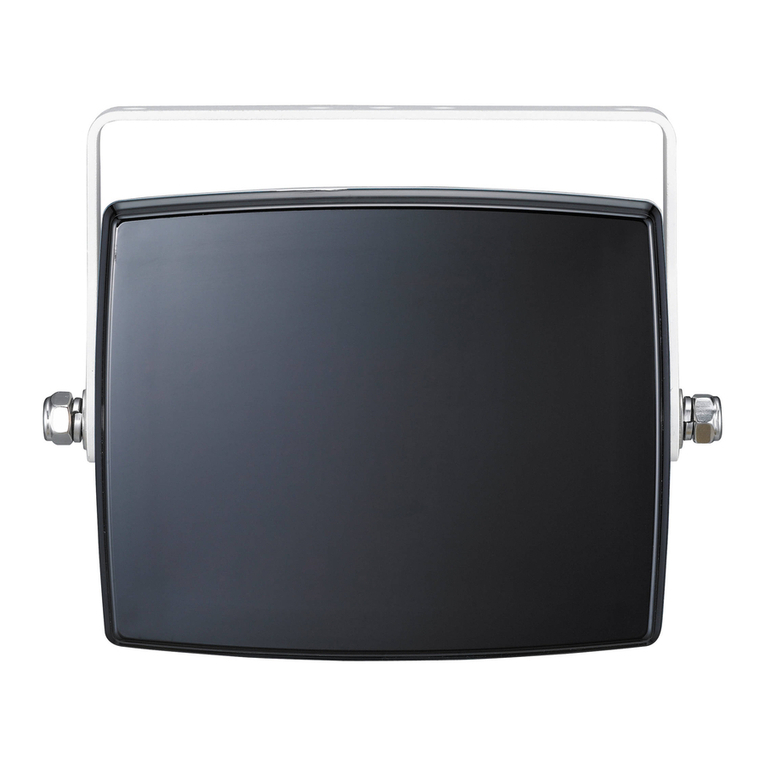
Samsung
Samsung SPI-10 user manual
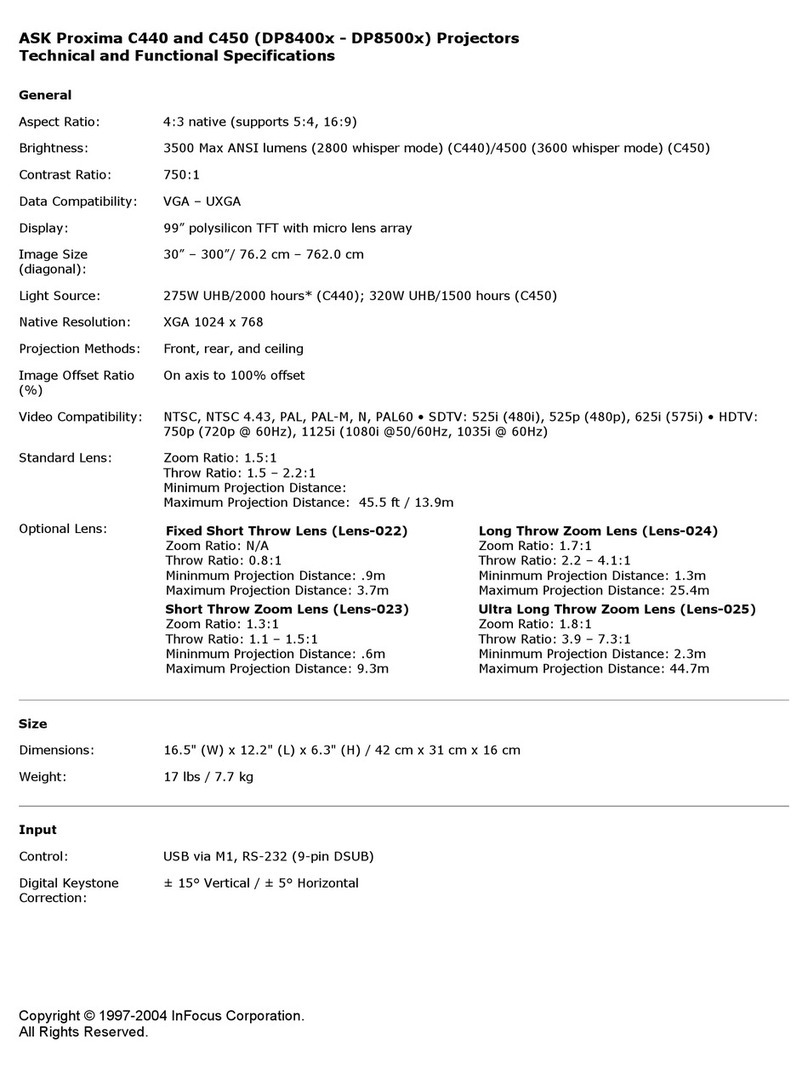
Ask Proxima
Ask Proxima C440 Tehnical and Functional Specifications

Optoma
Optoma W505 datasheet

Panasonic
Panasonic PT-LB10NTU - Mobile Proj XGA 2000 Lumens 4.9LBS Cross Platform... operating instructions
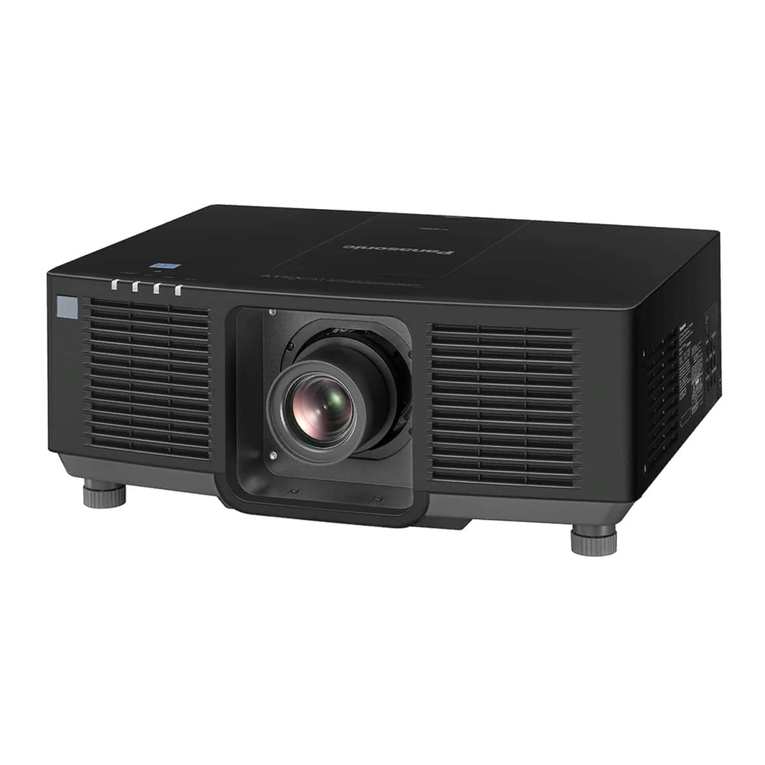
Panasonic
Panasonic PT-MZ880 operating instructions

Epson
Epson LightScene EV-110 user guide
